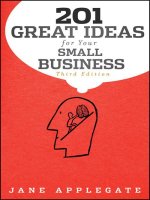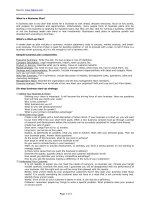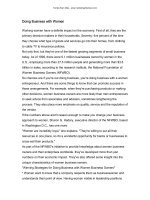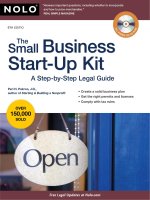Improving Small Business Cash Flow ppt
Bạn đang xem bản rút gọn của tài liệu. Xem và tải ngay bản đầy đủ của tài liệu tại đây (173.88 KB, 8 trang )
Improving Small Business Cash Flow
Craig Alexander Orr MBA, MSc, HND
Copyright 2011 Craig Orr
Smashwords Edition
Discover other titles by Craig Orr at Smashwords.com:
Finding Cash in Your Business - />If you have access to the Internet you can jump to the enhanced content of this book by
clicking on the links below. The links will connect you with the podcast, the blog, presentations, the
obligatory twitter feed and of course the website www.craigscopy.com.
Cash in your Business Podcast
slideshare
Blogger
Twitter
Any trademarks, service marks, product names or named features are assumed to be the
property of their respective owners, and are used only for reference. There is no implied
endorsement if they are used.
Finally, use your head. Nothing in this book is intended to replace common sense, legal,
medical or other professional advice, and is meant to inform and entertain the reader. So have fun
finding the Cash in Your Business.
Smashwords Edition, License Notes
Thank you for downloading this free ebook. You are welcome to share it with your friends.
This book may be reproduced, copied and distributed for non-commercial purposes, provided the
book remains in its complete original form. If you enjoyed this book, please return to
Smashwords.com to discover other works by this author. Thank you for your support.
Table of contents
Chapter 1 - Introduction
Chapter 2 - The Cash Flow Formula
Chapter 3 - Focus on Cash Customers
Chapter 4 - Strategic Solutions Plan
Chapter 5 - Conclusion
Chapter 1
Introduction
Cutting costs and improving Cash Flow is where all small businesses need to be right now. The big
question is where do you start? This guide provides the steps to help you to rapidly find the Cash buried
in your business.
Recently the owner of a small business said to me I am quoting for more business opportunities than
ever before, converting less, constantly running short of time and my costs keep going up. He showed
me into his office where ring binders full of quotes that had not converted to orders were stacked in waist
height piles, taking up valuable floor space. May I first say that these guys were experts at filling quotes,
with a keen eye for methodical approach, and if that had been their core business they would have been
very profitable. Mentally I could see cash sticking out of the ring binders and falling onto the floor. He
asked me the obvious question why have I lost out on so many quotes? His business was a car body
repair shop and rather than provide an answer to a subject I knew nothing about. I asked him to indulge
me as we started to evaluate how much money he had invested in creating the stacks of quotes. The
results were staggering in one year alone he had investing about two years wages, which had ultimately
feed through to his bottom line costs and explained why he was busier without seeing any improvement
in cash flow.
Small businesses cannot afford the luxury of doing “business as usual” in a recessionary
environment it is critical to re-evaluate how your business operates. Download The Business survival
workshop - to focus your business on what you do best.
Cost cutting can be a bit like liposuction, providing an unsustainable quick fix, unless you make the
required life style changes the problem will quickly comes back. This short guide will provide pointers
to help you assess where you may have developed habits that are stopping you from being more
profitable.
First stop is a process of Cash Flow triage; identifying where the big issues are. Once the issues are
identified it’s time to create a strategic solutions plan. This enables the small business to achieve the
greatest returns within the shortest amount of time. The strategic solutions plan will ensures that the life
style changes required to sustain cost management and improve long-term business performance become
embedded into the day to day running of the business.
The Cash Flow Formula was developed after extensive research into understanding and
improving the way companies handle Cash. The circular wheel shown below is the ‘aide memoire’
to drive a systematic approach to the analyse. Each of the segments in the circle are broken down in
detail in the various resources available at and in the Finding Cash in
Your Business ebook- />Cash in Strategy
With most of the world’s economies at their worst condition since World War 2, as never before a clear
“Cash in” strategy plays an important role in a small business’s success. In today’s turbulent competitive
environment, companies more than ever need a “Cash in” strategy that keeps reminding them of the
competitive advantage achieved by being smarter with cash.
As the Global recession bites it is important to review your current business product or service and
customers mix as a priority. It may be that your order book is still full making you feel insulated from the
recession. When in fact what you are actually experiencing is the effect of customers who are progressing
orders that were approved years in advance, and the current market condition may not take effect for months or
years. The key question here is can your customers still afford to pay?
AIR
In preparing for the future your small business needs to:
Adapt to the market conditions; create an action plan based on what products and or services
are most likely to continue to be sold in a recessionary environment.
Initiate collaborative discussion with existing customers and suppliers who are struggling.
Review existing and target customers and set new credit limits and create risk bandings based
on which companies are most likely to survive.
Remember you cannot live without AIR.
Adapt to the market, Initiate Dialogue and Review Customers.
Chapter 2
The Cash Flow Formula
The Cash Flow Formula has been adapted to help you develop a systematic approach to
understand and improve the cash flows within your businesses. The Formula knits together a
number of accepted management techniques such as ratio analysis and Pareto to arrive at the Cash
Flow Formula.
The Formula can be started at any of the seven segments, especially if you already have
identified areas of concern, or a segment dose not apply to your company, however, generally in
small business environment jumping straight to Credit Control will have the biggest impact on
improving Cash Flow.
Here are the 7 segments:
Competitors
Identify the key customer requirements used to compare you with your competitors. Focus the
business on improving those key customer requirements. Communicate the improvements to your
customer base.
Cash Flow by Company
Focus in on the area of the company that is expected to demonstrate the highest returns in the
medium term. Where there is high growth potential the greatest opportunity for poor financial
controls exists.
Business Model
Analyse your business model against the business’s current performance. Challenge yourself
as to if the business model is still current and the operational strategy derived from that is still
correct.
Internal Accounts
Take a close look at the Internal Accounts. Graph them over a 4-month period and compared
them to the previous years results over the same period. This trend analysis is used to highlight
areas where cash flow improvements are required.
Product contribution
Determining which products have the greatest contribution to the company’s profits can be
used to focus future product developments and withdrawals. The highest contributing products will
have the greatest impact on the management of Cash flows.
Cash Flow by Product/Service
Detailed deconstruction and mapping of the Working Capital Cycle (WCC) for each of the
products is used to determine which products or services provide the best use of cash within the
business, it also ensures that suppliers credit terms are controlled and managed effectively.
Credit control.
Analyse when customers pay their bills so that irregularities can be identified before large debts
are amassed. Understanding the key dates in the WCC for a product or service allows better use of
the credit given by vendors and the debt owed by customers.
Chapter 3
Focus on Cash Customers
Whether you are a small business or a large corporate “Having too many customers can break
you, and focus on Cash Customers is essential!” What many businesses don't get, is that the
customer acquisition and maintenance cost are normally far greater, than the money the customer
will spend with you on their first sale. On average a business need to bring each customer back at
least 5 times before they will begin to generate a profit and become good quality Cash customers.
One business I looked at had just over 700 customers, but was struggling to sell into their
customer base.
• Initially I asked for a historical list of how much each customer had spent with the
company.
• My next question was how many customers regularly do business with the company. Of
the 700 only 70 regularly did business with the company.
• Now comes the crucial question ‘of the 70 how many pay their bills on time or at all?’
now we are down to 30.
• I then asked for credit ratings for the 30 left and that brought the number of good Cash
customers down to 20.
The company had made the fatal mistake of not understanding the cost of customer acquisition
and maintenance. The expectation was that all customers are equal and so they were shared out
equally amongst the sales staff.
The average business spends 6 times more trying to win a new customer, than it does
generating new business from an existing customer.
In recognition of this fact the solution required a combination of reducing the size of the sales
team and providing a more appropriate level of account management.
The company now focuses on supporting the top 20 accounts with sales executives. The other
680+ accounts are managed by a combination of a telesales team and the bailiffs.
A typical fully loaded Sales Executive cost to the business was £100,000 and there were 30 in
the team including managers. Each sales executive handled over 20 customers. The business was
spending around £3m supporting customers who had no intention of buying. In fact only 1 out of
every 35 customers was worth supporting.
Contrary to popular opinion creating a smaller Sales team increased motivation, productivity,
salary and sales. The new smaller team had a reduced management overhead and had improved the
profit from existing turnover by around 7%.
The Sales executives had more time to spend with each of their customers that meant they
delivered a better quality of service and this in turn encouraged the customer to place more orders.
It was true that the business had redeployed staff but by doing so it more than just secured the
jobs of all that remained.
The business was now running much more efficiently, it has seen an on-going improvement to
turnover, and is in a much better place to manage the growth of the sales team going forward.
Chapter 4
Strategic Solutions Plan
Small businesses suffer at the hands of large businesses, as the pain of recession passes down
the food chain. Small businesses are being asked to take drastic action, drawing up wish lists of
things that need to be completed to improve their Cash position as the banks begin to recapitalise
and ration financial support. Time is critical, focus is paramount and a strategic solutions plan is
essential.
Banks no longer role out the red carpet, and angel investors want to see if the companies they
invested in are capable of generating free cash flow (FCF) before they decide to invest any more
money.
The working capital cycle shown below is an integral part of understanding a business’s capital
requirements, it’s capacity to service external debts, it’s ability to sustain growth and it’s potential to
generate free cash flow.
Using the Cash Flow Formula to highlight the areas that will provide the biggest improvements
in Cash flow in the shortest period of time a strategic solution plan can be implemented. The plan
ensures that the life style changes required to sustain cost management and improve long-term
business performance become embedded into the companies’ culture.
The strategic solutions plan should include the following;
The detailed cash flow evaluation highlighting areas of concern
A detailed improvement Solutions report detailing any changes to the way the business
needs to operate. The report should include any 3rd Party Supplier proposals required, and a
proposed implementation timetable.
No matter where your finances are today, improving Cash Flow will help you to optimise or
transform the performance of Your Business.
Chapter 5
Conclusion
This guide has provided you with an overview of the steps required to analyse and improve the
Cash Flow within your business; recent market conditions have had a dramatic impact on the global
markets, and as never before the lifeblood of the cash needs to pump through your businesses
arteries.
The global economy has started to contract and is unlikely to revert back to the heady days of
double-digit growth, at least for a while. So, for a while it will be hard to raise a loan or equity
capital, except for companies already generating free cash flow or those with a strong emphasis on
cash control. So the key to surviving the global credit crunch is to look for cash in your Business,
find it, handle it well and look for the golden opportunities it creates.
###
About the Author:
Craig is a Business strategist with a fresh market perspective combining technological
awareness, deliverable experience with strong cost management and leadership skills. Craig likes to
think of himself as the engineer who understands costs. Craig holds both an MSc from Cranfield
and an executive MBA from Bradford. He has assisted Companies from start up to FTSE 100 in
nearly every region of the world for over 25 years. He states “that to survive in today’s competitive
marketplace companies need to focus on their core strengths, and outsource the areas that do not
differentiate them from the competition.” Whilst completing his studies Craig remodelled the
business plan for the company he was working for making them the most cost aware and successful
business in the sector. That success propelled him into BT where he was responsible for targeting
outsourcing opportunities, which now generate revenues in excess of £200m, and supports all
targeted communications providers.
Discover other titles by Craig Orr at Smashwords.com:
Finding Cash in Your Business - />I’m sure on the basis of this guide you’ve got questions and comments. I trust the information
shared has struck a chord with you. There’ll be other areas you want me to expand upon. Either
way I want to hear from you…
Connect with Me Online:
Smashwords: />Podcast: Cash in Your Business podcast
Blog: />Twitter: />









